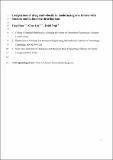Comparison of drag and velocity in model mangrove forests with random and in-line tree distributions
Author(s)
Shan, Yuqi; Liu, Chao; Nepf, Heidi
DownloadAccepted version (15.58Mb)
Publisher with Creative Commons License
Publisher with Creative Commons License
Creative Commons Attribution
Terms of use
Metadata
Show full item recordAbstract
This study examined the role of tree arrangement (random versus aligned) on the drag forces and velocity inside a 1/12th-scale model mangrove forest over a range of tree density (trees m−2). Each model tree included an aerial root system geometrically similar to Rhizophora, with maximum root height HRmax and water depth H > HRmax. The non-dimensional root density was defined as ar HRmax, with root zone frontal area per volume, ar. For both random and aligned low-density forests, ar HRmax < 0.1, the vertical profile of velocity followed a boundary layer shape. Within both random and aligned high-density forests, ar HRmax > 0.1, the velocity was diminished in the root zone (z < HRmax) and enhanced above the root zone, relative to the boundary layer profile. For all forest arrangements, the force on the roots dominated the force on the entire tree, even in cases with diminished velocity within the root zone. Compared with a tree at the leading edge, a tree inside a randomly distributed forest could experience either a greater or lesser force, and the variation in drag force increased with tree density. In contrast, for an aligned distribution of trees the force on an individual tree within the forest was always diminished relative to a tree at the leading edge. A drag coefficient was defined using a quadratic drag law. The forest-average drag coefficient, defined using the channel-average velocity, was up to 30 percent higher for random tree arrangements, compared to in-line tree arrangements.
Date issued
2019-01Department
Massachusetts Institute of Technology. Department of Civil and Environmental EngineeringJournal
Journal of Hydrology
Publisher
Elsevier BV
Citation
Shan, Yuqi et al. "Comparison of drag and velocity in model mangrove forests with random and in-line tree distributions." Journal of Hydrology 568 (January 2019): 735-746 © 2018 Elsevier B.V.
Version: Author's final manuscript
ISSN
0022-1694